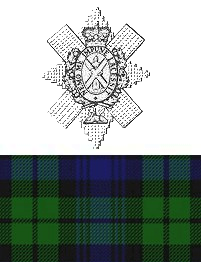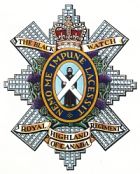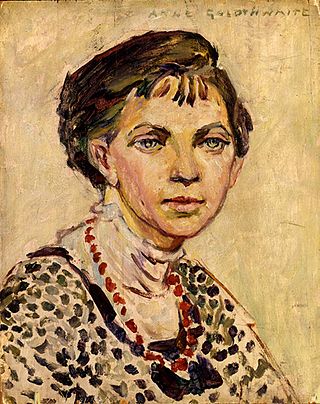Related Research Articles

The Black Watch, 3rd Battalion, Royal Regiment of Scotland is an infantry battalion of the Royal Regiment of Scotland. The regiment was created as part of the Childers Reforms in 1881, when the 42nd Regiment of Foot was amalgamated with the 73rd (Perthshire) Regiment of Foot. It was known as The Black Watch from 1881 to 1931 and The Black Watch from 1931 to 2006. Part of the Scottish Division for administrative purposes from 1967, it was the senior Highland regiment. It has been part of the Scottish, Welsh and Irish Division for administrative purposes since 2017.

The Black Watch of Canada is a reserve infantry regiment in 34 Canadian Brigade Group, 2nd Canadian Division, of the Canadian Army. The regiment is located at 2067, rue Bleury in Montreal, Quebec, Canada, and is currently commanded by Lieutenant-Colonel R.M. Unger, MMM,CD. The regiment's armoury was designated a National Historic Site of Canada in 2008. They are the senior Canadian-Scottish Regiment.

The etching revival was the re-emergence and invigoration of etching as an original form of printmaking during the period approximately from 1850 to 1930. The main centres were France, Britain and the United States, but other countries, such as the Netherlands, also participated. A strong collector's market developed, with the most sought-after artists achieving very high prices. This came to an abrupt end after the 1929 Wall Street crash wrecked what had become a very strong market among collectors, at a time when the typical style of the movement, still based on 19th-century developments, was becoming outdated.

The Seaforth Highlanders was a line infantry regiment of the British Army, mainly associated with large areas of the northern Highlands of Scotland. The regiment existed from 1881 to 1961, and saw service in World War I and World War II, along with many smaller conflicts. In 1961 the regiment was amalgamated with the Queen's Own Cameron Highlanders to form the Queen's Own Highlanders, which merged, in 1994, with the Gordon Highlanders to form the Highlanders. This later joined the Royal Scots Borderers, the Black Watch, the Royal Highland Fusiliers and the Argyll and Sutherland Highlanders to create the present Royal Regiment of Scotland.

Rembrandt Harmenszoon van Rijn, usually simply known as Rembrandt, was a Dutch Golden Age painter, printmaker, and draughtsman. He is generally considered one of the greatest visual artists in the history of art. It is estimated Rembrandt produced a total of about three hundred paintings, three hundred etchings, and two thousand drawings.

Edmund Blampied was one of the most eminent artists to come from the Channel Islands, yet he received no formal training in art until he was 15 years old. He was noted mostly for his etchings and drypoints published at the height of the print boom in the 1920s during the etching revival, but was also a lithographer, caricaturist, cartoonist, book illustrator and artist in oils, watercolours, silhouettes and bronze.

William Frederick Longstaff was an Australian painter and war artist best known for his works commemorating those who died in the First World War.

Norman Wilkinson was a British artist who usually worked in oils, watercolours and drypoint. He was primarily a marine painter, but also an illustrator, poster artist, and wartime camoufleur. Wilkinson invented dazzle painting to protect merchant shipping during the First World War.
Joseph Johnston Lee (1876–1949) was a Scottish journalist, artist and poet, who chronicled life in the trenches and as a prisoner of war during World War I. He is also remembered for his dispute with then poet laureate Robert Bridges over the literary value of Robert Burns' work. He has been described as "Scotland's 'Forgotten' War Poet", as well as "Dundee's forgotten war poet."

The 7th (Meerut) Division was an infantry division of the Indian Army and before 1895, the Bengal Army, that saw active service during World War I.

Edward Thomas Daniell was an English artist known for his etchings and the landscape paintings he made during an expedition to the Middle East, including Lycia, part of modern-day Turkey. He is associated with the Norwich School of painters, a group of artists connected by location and personal and professional relationships, who were mainly inspired by the Norfolk countryside.

William Barnes Wollen was an English painter mostly known for his paintings of battle and historical scenes and sporting events.
James Prinsep Beadle was an English painter of historical and military scenes.

William Lamb RSA was a British sculptor and artist. He was a survivor of the "lost generation" who came of age in 1914, and was scarred, both mentally and physically, by the First World War.

James McBey was a largely self-taught Scottish artist and etcher whose prints were highly valued during the later stages of the etching revival in the early 20th century. He was awarded an Honorary Doctor of Letters by Aberdeen University.

Anne Goldthwaite was an American painter and printmaker and an advocate of women's rights and equal rights. Goldthwaite studied art in New York City. She then moved to Paris where she studied modern art, including Fauvism and Cubism, and became a member of a circle that included Gertrude Stein, Henri Matisse, and Pablo Picasso. She was a member of a group of artists that called themselves Académie Moderne and held annual exhibitions.

The Defence of Festubert was an engagement on the Western Front early in the First World War when Indian and British battalions of the 7th (Meerut) Division of the Indian Army defended the village of Festubert against a German attack from 23 to 24 November 1914. It was one of the first actions in the war in which an attack was made against a prepared defensive position. The British and Indian regiments that took part were awarded the battle honour Festubert 1914.

Andrew Paterson was an internationally renowned and multi-award-winning Scottish portrait photographer whose services were sought over several decades by many leading political and commercial figures.
The Black Watch Brigade was a Territorial Force infantry brigade of the British Army. Formed in 1908, it was not part of any division, instead being assigned to Coastal Defence duties in Scottish Command. It was dissolved in early 1915 as its constituent battalions were posted to other formations.
The 2/1st Black Watch Brigade was a 2nd Line Territorial Force infantry brigade of the British Army in World War I. The brigade was formed as a duplicate of the Black Watch Brigade in January 1915. As the name would suggest, it was organized with four battalions of the Black Watch, It was dissolved in November 1915 as its constituent battalions were posted to other formations.
References
- 1 2 3 The Joseph Gray website, http://www.josephgray.co.uk
- 1 2 M. Hall - The Artists of Northumbria, 1982.
- ↑ Johnson & Creutzner - The Dictionary of British Artists 1880-1940.
- ↑ Dundee Advertiser, December 1917-January 1918.
- ↑ Imperial War Museum. War Artists Archive. First World War. File number 192/3.
- ↑ "WAR AS IT IS. THE SEAFORTHS AT NEUVE CHAPELLE," The Inverness Courier, 23 September 1920.
- ↑ "DUNDEE'S OWN MEMORIAL OF NEUVE CHAPELLE," Dundee Advertiser, 1 April 1922.
- ↑ Imperial War Museum Archive. Major J. Gray 83/38/1.
- ↑ The Andrew Paterson website, http://www.patersoncollection.co.uk
- ↑ 6 artworks by or after Joseph Gray , Art UK . Retrieved 3 March 2014.
- ↑ "WORLD WAR I EXHIBITION AT THE HIGHLANDERS' MUSEUM," The North Magazine, Autumn 2013, pp32-33.